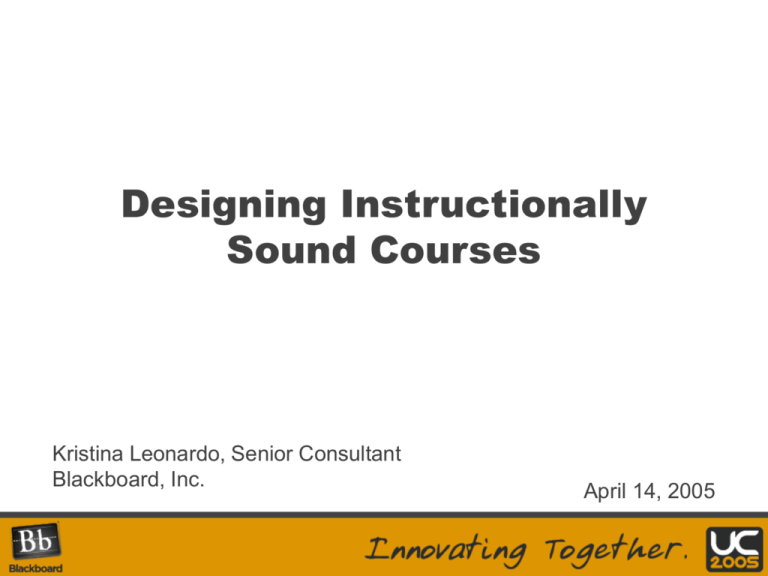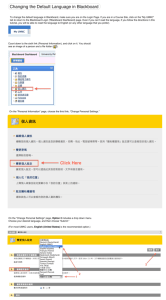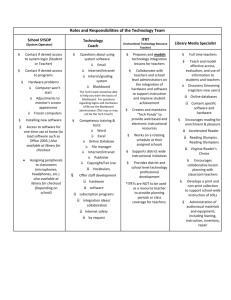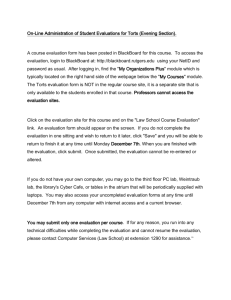Designing Instructionally Sound Courses
advertisement

Designing Instructionally Sound Courses Kristina Leonardo, Senior Consultant Blackboard, Inc. April 14, 2005 About the Trainer Kristina M. Leonardo • Senior Consultant, Blackboard Training • Professional Experience Courseware/Web Designer, Center for Teaching, Learning & Technology, Pace University Adjunct Professor, CSIS, Pace University Agenda • • • Course Demo ADDIE Instructional Design Model Designing a Blackboard Course – Course Menu – Text Box Editor – Course Tools • Best Practices of Effective Course Design The ADDIE Instructional Design Model • • • • • Analyze Design Develop Implement Evaluate Analysis • • • • • Who are the intended learners? What do they need to learn? What are the delivery options? What constraints exist? How much time exists to develop the course? • What will the students do to determine competency? Interface v. Instructional Design • Instructional Design: The systematic process of translating principles of learning and instruction into specifications for instructional materials and activities* • Interface Design: The process of developing a consistent, user-friendly, attractive layout *Smith & Ragan, Instructional Design, 1993 Instructional Course Design • Write course objectives • Develop the course syllabus • Develop the course outline and schedule • Design the course’s organization; outline units, lessons, and modules • Identify learning activities – Reading assignments – Writing assignments – Oral presentations – Discussions Interface Course Design • • • • • • • • • Simplicity Consistency Identity/Personalizing your Course User-Friendly Navigation Compatibility Universality Layout Font/Colors Multimedia Development • Generate and deploy course documents and materials for delivery • Obtain and/or create the required media – Different multimedia formats to ensure the learners' preferences can be met • Determine the appropriate interactions • Plan activities and student group work to help construct a sense of community – General Questions Discussion Forum – Support Links Implementation • Initial contact letter – How/when to log in – Textbook information • Deliver the instruction as designed • Provide constant feedback to students • Be prepared for technical problems to occur • Be flexible- adjust a particular teaching strategy if necessary Evaluation • Plan several points during the course when students can provide anonymous feedback • Collect, process, analyze and interpret data to determine whether education has met its objectives • Identify aspects of the process that should be strengthened • Conduct formative evaluations to improve the course and summative evaluations to judge the effect of the course Planning a Blackboard Course • Brainstorm ideas – – • • • • • Course Objectives Learning Materials Login your Blackboard course site Customize the look and feel of your course (create new navigation buttons, if needed) Define your content organization style Upload content Test run your course Text Box Editor: WYSIWYG & Spell-Check • Blackboard’s WYSIWYG functionality appears throughout the Blackboard Learning System application in standard text boxes, including the content and assessment areas. • The application has full spell check capabilities for all text boxes. • Blackboard’s WYSIWYG capabilities include: – Font Type, Size, and Coloring – Multimedia support including Images, Audio, Video, Flash, Real, and more – Drag and Drop support – Tables and Hyperlinks – Undo and Redo support What is Effective Course Design? • Formal planning of a course and the creation of activities and events, with a focus on effective learning outcome, that will help your students to learn independently and collaboratively • A plan to create activities and present your content in ways that motivate your students Source: You Can Teach Online: Building A Creative Learning Environment. by Gary S. Moore, Kathryn Winograd, Dan Lange Three Steps to Effective Course Design • Identify desired outcome and results - Learning objectives : Task Analysis, User Analysis • Determine and Plan how you will present and teach your course - Prepare syllabus for a web-based course - Create learning materials and activities • Plan instructional strategies or activities that will assess your students and the effectiveness of your course - Course activities - Quizzes, tests, preview tests, survey, course evaluation Source: Understanding by Design. Association for Supervision and Curriculum Development. 1998 by Grant Wiggins and Jay McTighe Best Practices for Effective Course Design • • • Encourage Contact between Students and Faculty Develop Reciprocity and Cooperation Among Students Use Active Learning Techniques • • • • Give Prompt Feedback Emphasize Time on Task Communicate High Expectation Respect Diverse Talents and Ways of Learning Blackboard Training Services Visit http://education.blackboard.com for more information about . . . • Onsite Training Workshops • Online Training Courses • Regional Training Events • Building Blocks Training • Technical Training – Coming Soon! If you have any questions, please email educationalservices@blackboard.com Thank you for choosing Blackboard!


